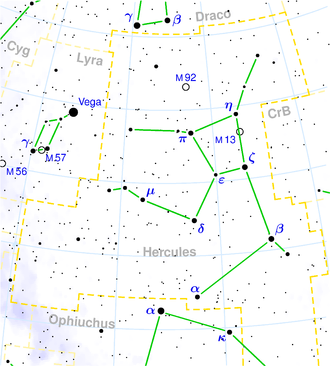NGC 6301
| Galaxy NGC 6301 / IC 4643 |
|
|---|---|
![NGC 6301 [1] SDSS image](https://upload.wikimedia.org/wikipedia/commons/thumb/4/47/NGC6301_-_SDSS_DR14.jpg/300px-NGC6301_-_SDSS_DR14.jpg)
|
|
| NGC 6301 SDSS image | |
| AladinLite | |
| Constellation | Hercules |
|
Position equinox : J2000.0 , epoch : J2000.0 |
|
| Right ascension | 17 h 08 m 32.740 s |
| declination | + 42 ° 20 ′ 20.82 ″ |
| Appearance | |
| Morphological type | Scd: |
| Brightness (visual) | 13.5 likes |
| Brightness (B-band) | 14.2 mag |
| Angular expansion | 1.8 ′ × 1.1 ′ |
| Position angle | 115 ° |
| Surface brightness | 14.1 mag / arcmin² |
| Physical data | |
| Redshift | 0.027833 ± 0.000033 |
| Radial velocity | 8344 ± 10 km / s |
|
Stroke distance v rad / H 0 |
(381 ± 27) x 10 6 ly (116.8 ± 8.2) Mpc |
| history | |
| discovery | Wilhelm Herschel |
| Discovery date | June 11, 1788 |
| Catalog names | |
| NGC 6301 • IC 4643 • UGC 10723 • PGC 59681 • CGCG 225.49 • MCG + 07-35-34 • IRAS 17069 + 4224 • 2MASX J17083273 + 4220208 • GC 4274 • H IV 57 • LDCE 1238 NED010 • NVSS J170831 + 422032 | |
NGC 6301 = IC 4643 is a 13.5 mag bright spiral galaxy of the Hubble type Sc in the constellation Hercules in the northern sky . It is estimated to be 381 million light-years from the Milky Way and about 200,000 light-years across.
In the same area of the sky are u. a. the galaxies NGC 6311 and NGC 6312 .
The object was discovered on June 11, 1788 by Wilhelm Herschel with an 18.7-inch reflector telescope, who described it as "a vS, F star involved in eF nebulosity". In his “Philosophical Transactions” of 1791 he wrote in retrospect “Suspected, stellar. By a second observation it is verified, and called a very small star involved in extremely faint nebulosity ". Due to an error in Herschel's position information, the observation of the same galaxy by Johann Palisa in 1896 led to a further entry in the index catalog under IC 4643 .
Web links
- NGC 6301. SIMBAD , accessed on July 19, 2019 (English).
- NGC 6301. DSO Browser, accessed July 19, 2016 .
